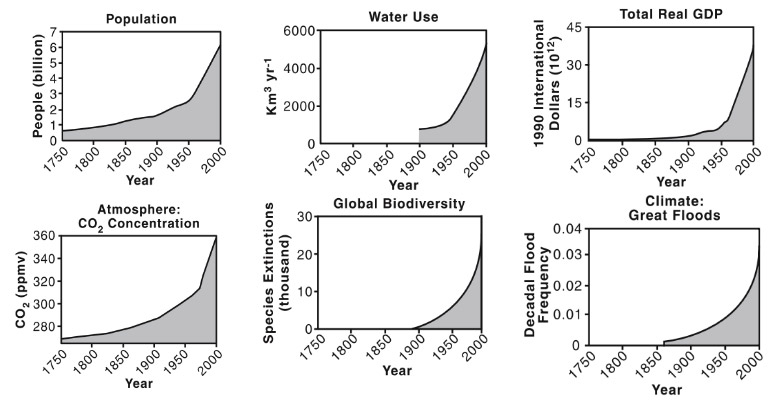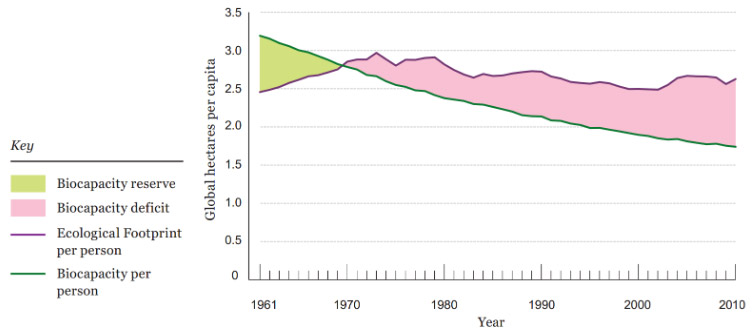
November 2014 – In July 2014, the Nexus Network commissioned 13 think pieces with the remit of scoping and defining nexus approaches, and stimulating debate across the linked domains of food, energy, water and the environment. The Cambridge Institute for Sustainability Leadership’s Jake Reynolds and Gemma Cranston have co-written a think piece entitled ‘Nexus thinking: can it slow the Great Acceleration?’ that explores how business success and corporate decision-making could be shaped by nexus thinking.
Nexus thinking: can it slow the Great Acceleration?
Dr Jake Reynolds and Dr Gemma Cranston[i]
Nexus Network think piece, November 2014
In business, success tends to be measured in terms of profitability, stock price and market share. Firms like to be at the top of market share league tables or rankings that highlight their size, growth or attractiveness to investors. There is an implicit sense that growth is necessary for survival; and that the right people and strategies can deliver it, endlessly. The question explored here, admittedly at a high level, is whether these measures of success are the right ones in an economy that is reliant on a depreciating base of natural capital[ii]. What would success look like if one was to take this into account, and design business strategies accordingly? As well as profitability, stock price and market share, what other metrics would guide business growth?
Throwing down the gauntlet
Will Steffen’s ‘Great Acceleration’[1] reveals the extent to which human activity is shifting us into a new geological epoch known as the Anthropocene. Large-scale changes in the Earth’s economic, physical and biological systems are being been observed (Figure 1) across a wide range of factors, from population and water use to GDP, atmospheric CO2 concentration and frequency of flooding. One interpretation of the ‘Great Acceleration’ is that, since the 1970s, humanity’s demand for natural capital (its Ecological Footprint[2],[3],[4], has outstripped the planet’s ability to regenerate its biocapacity (Figure 2). In parallel, the draw down on fossil and mineral resources continues at a pace.
This is the situation today. Before long, however, we can expect the human population to move closer to 9.6 billion[5], with a resulting sharp increase in demand for food, water and energy. On current trends, many of these people will be eating more than at present, and differently, in particular a diet that is richer in meats and processed foods – in short energy and water-intensive foods. The interplay between these elements and the impact upon the climate is modelled in a recent study relating global food security to the expansion of crop and pastureland, and the resulting growth of greenhouse gas emissions[6].

Figure 1: The Great Acceleration – 1950 marked the beginning of a massive acceleration in human activity and large-scale changes in the Earth system[7]

Figure 2: Trends in Ecological Footprint and biocapacity per capita[8]
What conclusion should one draw? That the loss of relative biocapacity is unimportant for human societies, that the Earth’s natural systems are more resilient than scientists imagine? That we do not mind laying a considerable problem at the feet of future generations and more marginalised communities today? That we believe new technologies, spurred on by market forces, will solve all of these correlated challenges? A mix of the above?
Many would abhor these sentiments, yet no country has remotely achieved sustainability in this sense and, similarly, no business. Instead we continue to invest in economic activities that result in environmental damage and, somewhat perversely, record this positively as progress.
Nexus thinking – defined here as the ability to hold key developmental variables together when searching for solutions – is one response to this challenge. And while those variables relate to human rather than natural demands – food, water, energy and environment – the fact that they are both interdependent and reliant on the Earth’s core physical and natural systems to deliver makes Nexus thinking a particularly attractive, holistic and powerful vehicle for analysing business and policy problems.
Nexus challenges are everywhere. Just as we are focusing on energy, water and food, other domains of nexus thinking are apparent; for example between policy, business and academia, each struggling to make headway on impossibly complex challenges without necessarily finding ways to engage the others. The ethereal nature of the Nexus can make it difficult for companies to use it to support their decision-making. As a result, nexus thinking is too often confined to conceptual discussions. In order to connect nexus thinking to business practice, a body of evidence must first be built up – one that uses real commercial situations as its source material.
The business of the Nexus
Most large companies have set goals to reduce their environmental impacts, and can point to case studies showing how they are meeting them. In the main these goals focus on reducing short-term use of energy, water and materials, while achieving lower emissions, pollution and waste. This can position the company favourably with customers, employees and the general public (for example see Nestlé[9]), and indeed corporate reports are filled with activities of this kind. Yet few companies have determined how to lessen their dependence on natural systems and resources to the extent that those systems maintain their ability to regenerate. None have achieved what might be described as the ultimate objective of this exercise, to become ‘Net Positive’[10] in soil health, water utilisation and biodiversity. There are many explanations of why this is the case. One potentially overlooked reason is that the company is simply unaware of evidence linking environmental degradation to business losses.
So, can nexus thinking be one way to stimulate the shift from short-term incremental business responses to systemic change and corporate leadership? Businesses are on the front line of the Nexus – in fact they task themselves with providing the food, energy, water and in some cases the types of environment that societies want. In order to achieve this, at scale, in a competitive market, difficult compromises are constantly having to be made, resulting in near-continuous environmental, social and financial impacts.
It is, in fact, hard to find an example where environmental problems do not encompass nexus issues, or reveal business dependencies. However, companies still tend to handle different elements of the environment separately based on their specialist characteristics. Take water for example: the water footprint of a sugar-containing carbonated beverage has been estimated to be 150-300 litres of water per 500 ml bottle[11], which comprises both the water in the beverage and the water required for its manufacture and packaging, including industrial energy. A high level of water dependency presents a significant risk to a beverage producer like Coca Cola, justifying careful management. The company is committing to safely return to communities and nature an amount of water equal to what it consumes by 2020[12], a step towards aligning its business operations with the goal of sustaining biocapacity.
At the helm: business drivers for nexus thinking
Stepping back, there are two main drivers for business interest in the Nexus. Firstly, to avoid the cost implications of resource scarcity, environment-related physical damage such as flood, storm and drought – in short business stability. Secondly, to avoid the cost burden of future regulation in markets which have woken up to environmental decline and of reputational disasters in ones that haven’t. In some parts of the world both sets of signals are relatively weak, if growing. In these areas there is no short-term argument for taking the Nexus seriously beyond the much cited reputation and brand enhancing drivers[13],[14]. To do so is a leadership step which aligns well with companies seeking a competitive, cost or reputational edge to their sustainability activity.
A wide range of impact-based corporate programmes have been implemented over the last decade. However, when set in the context of the ‘Great Acceleration’ they are, at best, only sufficient to marginally postpone an ecological crisis. One reason why there are few, truly compelling examples at scale is that, as yet, companies have not found a sufficiently robust commercial logic that justifies investment. This relates, of course, to the policy and regulatory conditions in which the companies are operating and the resulting degree to which environmental and social externalities appear as real numbers on balance sheets. Some businesses are beginning to identify weak commercial drivers behind addressing environmental degradation. For example, a recent report from the brewer SABMiller and WWF[15] points to higher and more volatile input and raw material costs due to a growing demand for scarce resources such as water. Here, the link between environmental degradation and business results is articulated but not yet quantified, with focus placed instead on a singular target - reducing water consumption. Since 2008 SABMiller has reduced its absolute water consumption by 16 per cent[16] despite an increase in production volumes. Unfortunately such a statistic does not differentiate between the geographic contexts in which water is being sourced.
The harsh reality is that we still don’t have examples of companies that are making real, systemic and strategic changes to address the current downward trend in biocapacity in relation to spiralling global demands[17]. The cocoa supply chain is one of the few places where businesses are starting to see the commercial benefit of investing in natural capital. Demand for cocoa is rising but supply is dwindling and can only be sourced from a handful of developing countries. The decline in productivity has clear consequences for the market and, as such, companies like Mars are investing in research[18] to increase the quality and performance of cocoa plants.
Concluding remarks
Scale is needed to shift a problem as significant as the ‘Great Acceleration’. Scale is also what businesses need to achieve breakthroughs in market share and profitability. By orienting the one behind the other, it is possible that solutions to environmental degradation – at scale – will be catalysed. The challenge for businesses and researchers alike is to produce a compelling evidence base showing how this can be made to work in practice.
The nexus offers a lens through which companies can determine their natural resource options and trade-offs. However, until the private sector shifts gear from corporate sustainability programmes to strategic investment in natural capital, the Great Acceleration may simply continue. One critical enabler for this is public policy and regulation – internalising externalities on balance sheets. In lieu of this, or perhaps in parallel, there is an emphatic need for trusted empirical data and evidence to allow companies to make commercially interesting arguments for investing in natural capital, at scale.
As research on the nexus proceeds, academics from both the social and natural sciences may wish to consider how – or perhaps whether – their evidence will be absorbed by companies to create impact. Clearly, the most efficient way to ensure this happens is to involve the companies – as research users and partners – throughout the research process rather than at the end when conclusions have been made. A new frontier of nexus thinking exists for researchers willing to cross this boundary.
[i] University of Cambridge Institute for Sustainability Leadership
[ii] 'Natural capital' is an economic metaphor for the limited stocks of physical and biological resources found on Earth, and the limited capacity of ecosystems to provide ecosystem services (i.e. the direct and indirect contributions of ecosystems to human well-being)
[1] Steffen, W., Sanderson, R., Tyson, P., Jäger, J., Matson, P., Moore III, B., Oldfield, F. et al. (2006) Global change and the earth system: a planet under pressure. Springer.
[2] Global Footprint Network (2014). Available at: www.footprintnetwork.org
[3] Borucke, M., Moore, D., Cranston, G., Gracey, K., Iha, K., Larson, J., … Galli, A. (2013). Accounting for demand and supply of the biosphere ’ s regenerative capacity: The National Footprint Accounts ’ underlying methodology and framework. Ecological Indicators, 24, 518–533.
[4] Wackernagel, M., Cranston, Morales, J.C., and Galli, A. (2014). Ecological Footprint Accounts. In: Handbook Of Sustainable Development, 2014. Second Edition. Eds: Atkinson, G., Dietz, S., Neumayer, E., Agarwala, M.
[5] United Nations Population Division, United Nations Population Projections 2013 Revision (2013). Available at: www.un.org/en/development/desa/publications/world-population-prospects-the-2012-revision.html
[6] Bajželj, B., Richards, K. S., Allwood, J. M., Smith, P., Dennis, J. S., Curmi, E., & Gilligan, C. A. (2014). Importance of food-demand management for climate mitigation. Nature Climate Change, 4, 924–929. doi:10.1038/NCLIMATE2353
[7] Steffan, W. et al (2005). Global Change and the Earth System, Springer, pp 132-133. Available at: http://www.igbp.net/download/18.56b5e28e137d8d8c09380001694/Springer+IGBP+Synthesis+Steffen+et+al+%282004%29_web.pdf
[8] WWF (2014).Living Planet Report 2014: Species and spaces, people and places. Eds: R. McLellan, L. Iyengar, B. Jeffries, and N. Oerlemans . WWF, Gland, Switzerland
[9] Nestlé .(2014). Nestlé in society - Creating Shared Value and meeting our commitments 2013 Available at: www.nestle.com/csv
[10] Kingfisher. (2014). Kingfisher Net Positive Report 2013/14. Available at: www.kingfisher.com/netpositive/index.asp?pageid=1
[11] Ercin, a. E., Aldaya, M. M., & Hoekstra, A. Y. (2010). Corporate Water Footprint Accounting and Impact Assessment: The Case of the Water Footprint of a Sugar-Containing Carbonated Beverage. Water Resources Management, 25(2), 721–741. doi:10.1007/s11269-010-9723-8
[12] Coca Cola. (2012). Water Stewardship. Available at: http://www.coca-colacompany.com/sustainabilityreport/world/water-stewardship.html#section-recycling-wastewater
[13] Deloitte. (2014). 2014 global survey on reputation risk. Available at: http://www2.deloitte.com/content/dam/Deloitte/global/Documents/Governance-Risk-Compliance/gx_grc_Reputation@Risk%20survey%20report.pdf
[14] Ernst and Young (2010). Climate change and sustainability - Five areas of highly charged risk for supply chain operations. Available at: http://www.de.ey.com/Publication/vwLUAssets/EY_-_Five_areas_of_highly_charged_risk_for_supply_chain_operations/$FILE/EY-five-areas-of-highly-charged-risk-for-supply-chain-operations.pdf
[15] SABMiller and WWF. (2014). The water-food-energy-nexus: Insights into resilience development. Available at: https://www.sabmiller.com/docs/default-source/investor-documents/reports/2014/sustainability-reports/water-food-energy-nexus-2014.pdf?sfvrsn=4
[16] WaterBriefing. (2013). SABMiller water use cut 16% since 2008. Available at: http://www.waterbriefing.org/home/water-issues/item/7674-sabmiller-water-use-cut-16-since-2008
[17] Schatzke, M. (2014). Chocolate: Can Science Save the World's Most Endangered Treat?. Bloomberg. Available at: http://www.bloomberg.com/news/2014-11-14/to-save-chocolate-scientists-develop-new-breeds-of-cacao.html
[18] Mars. (2014). Mars and cocoa sustainability. Available at: http://www.mars.com/global/brands/cocoa-sustainability/cocoa-sustainability-approach/research.aspx

The Nexus Network
Funded by the ESRC, the Nexus Network brings together researchers, policymakers, business leaders and civil society to develop collaborative projects and improve decision-making on food, energy, water and the environment.
@uk_nexus | E: info@thenexusnetwork.org | T: 01273 678350 | www.thenexusnetwork.org
Nexus Network Project partners


 Dr Jake Reynolds
Dr Jake Reynolds Dr Gemma Cranston
Dr Gemma Cranston

